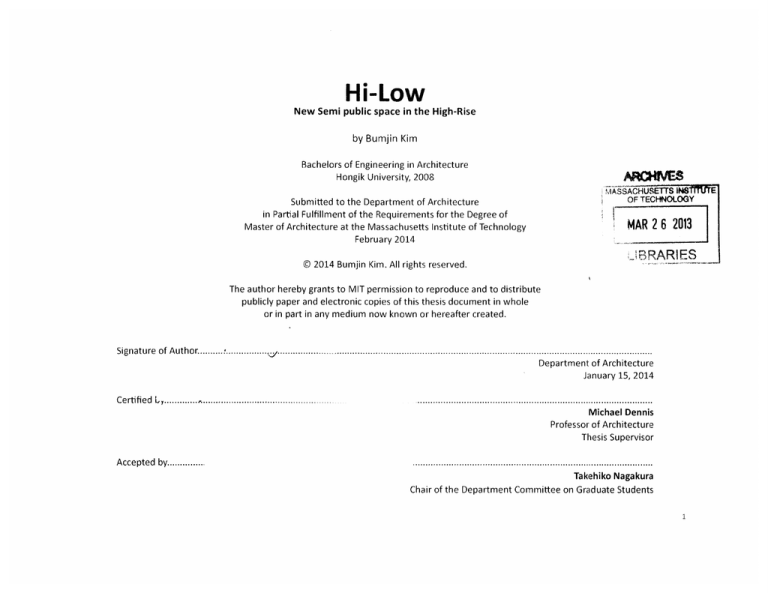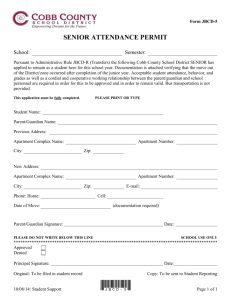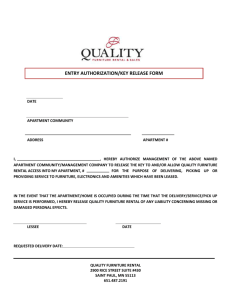
Hi-Low
New Semi public space in the High-Rise
by Bumjin Kim
Bachelors of Engineering in Architecture
Hongik University, 2008
1SSAOSTI
OF TECHNOLOGY
Submitted to the Department of Architecture
in Partial Fulfillment of the Requirements for the Degree of
Master of Architecture at the Massachusetts Institute of Technology
February 2014
MAR 2 6 2013
_'BRARIES
© 2014 Bumjin Kim. All rights reserved.
The author hereby grants to MIT permission to reproduce and to distribute
publicly paper and electronic copies of this thesis document in whole
or in part in any medium now known or hereafter created.
Signature of Author.
Certified
L......
.....................
...........
................................
....
....
...
...
......
............. .............
Department of Architecture
January 15, 2014
...
...
....
...
.......................
Michael Dennis
Professor of Architecture
Thesis Supervisor
Accepted by.............
...
I...
...
...
...
...
...
...
.....
...
.... I .......................
Takehiko Nagakura
Chair of the Department Committee on Graduate Students
1
.
',...............................................................
THESIS COMMITTEE
Thesis Supervisor:
Michael Dennis
Professor of Architecture
Department of Architecture
Thesis Readers:
Adele Naudd Santos
Professor of Architecture
Dean of the school of architecture and planning
Brandon Clifford
Belluschi Lecturer
Department of Architecture
3
Hi-Low
New Semi public space in the High-Rise
by Bumjin Kim
Submitted to the Department of Architecture
on January 15, 2014 in Partial Fulfillment of the
Requirements for the Degree of Master of Architecture
ABSTRACT
There has been a desire for new and unique design/environment such as by returning to the designs of Korean classic style, inviting star architects or holding international competitions. But, the reality of their design does not really express any new voice. Typical floor -plan is multiplied
in vertical, served three or four units, connected by weird mirror-surrounded elevators and emergency stairs. Small and narrow corridors cannot
really offer any proper space for social interaction.
Let's talk more about the inside of an apartment housing complex. First of all, even though there is trash in front of the apartment building,
nobody picks it up until the cleaning woman does something. This is the irony of high-rise apartment housing. No one wants to behave as if they
own the place. After parking their cars in the lot, people try to go to their private space as soon as possible, before they meet someone. That's
why the elevator hallway or inside of the elevator is the most uncomfortable space in the apartment building. There is no longer any kind of classic alley as in old villages which was a buffer area between public and private space. Without a buffer, combination of public and private space,
there are just two extremely different areas, public and private spaces in apartment complexes.
The thesis proposes a high-rise residential building by means of rethinking circulation and infrastructure. This new type of a high-rise residential
building enables residents to have a buffer zone between public and private space with a specific elements such as a elevator, a stair, or more
than that. This buffer zone in high-rise building helps to activate a semi-public space as a real neighbor.
Thesis Supervisor: Michael Dennis
Title: Professor of Architecture
5
ACKNOWLEDGMENT
Thanks to all you for your support
7
TABLE OF CONTENTS
01 Introduction
02 Daily Issues
03 Research
04 Analysis
05 Design Strategy
06 Design Proposal
07 Model Archives
08 Bibliography
9
...........................................
, I ............
....
01 Introduction
11
01
Introduction_dwelng
pattem
In Korea, the simple and monotonous design of apartment housing
has attracted criticism from people for a long time. In order to escape
from it, there has been a desire for new and unique design/environment such as by returning to the designs of Korean classic style,
inviting star architects (Daniel Libeskind, Ben Van Berkel) or holding
international competitions. But the reality of their design does not
really express any new voice. For example, returning to Korean classic
style only addresses the interior of Korean style. Apartment housing
designed by Daniel Libeskind and Ben Van Berkel is just superficial
luxury-'a brand.' Some people say that Libeskind's idea is a striking
and exceptional design for apartment housing. Although it is a unique
design, it is not about fundamental change of apartments but about
the exterior of apartment buildings.
How are architects responding and reply to this current situation,
given that we are familiar with the desire for a new kind of "apartment." Actually, there are no architects jumping into designing real
apartments because there is a limited menu of standard options for
apartment in Korea. As designers, architects are just choosing the a
pattern of tiles or brand of bathtub for now. The current apartment
system in Korea has another kind of problem, too. There are two separate organizations, which are a dwelling planning group and a site
(estate) plan group. None of group members are real architects. The
dwelling planning group is just focusing on selling points in order to
maximize the area of exclusive use space. The site plan group is just
trying to make a good-looking overall picture for their brochure. After
they figure out what they want, they put all the playgrounds and senior citizen centers in the leftover space. It does seem ridiculous, but
that is the reality right now in Korea. Then, are there any roles we can
contribute to apartment housing as 'a real architect'?
13
02 Daily Issues
15
......
02 Daily Issues_existng siuain
Even though there is trash
in front of the apartment
building, nobody picks it up
until the cleaning woman
does something. This is the
irony of high-rise apartment
housing. No one wants to
behave as if they own the
place. After parking their
cars in the lot, people try to
go to their private space as
soon as possible, before they
meet someone. That's why
the elevator hallway or inside
of the elevator is the most
uncomfortable space in the
apartment building.
-%ir--
A standard
wnit rype
-Wals fo Spces
A
standa"d unit type
urnixtr an intrio
NJ
II
t
....
There is no longer any kind of classic alley as in old villages which was a
buffer area between public and private space. Without a buffer, a combination of public and private space, there are just two extremely different
areas, public and private spaces in apartment complexes.
999
9*9*9*
*
+ *99*9*
*9*9*9
17
03 Research
19
03 Research_refere
Existing conditions
Typical floor -plan is multiplied in vertical, served three or four units,
connected by weird mirror-surrounded elevators and emergency stairs.
Small and narrow corridors cannot really offer any proper space for
social interaction.
An elevator is the only area for semi-public space.
Lobby is public space
A whole floor is for a gathering place such as gym, a community, or a
conference room.
-------------
T_-F
X
------------------------
1_4
ri
SECTION
PLAN
SECTION
PLAN
SECTION
PLAN
Reference
The entrance door is the only element that directly-relates the
interior to the out door space. The apartment has at least three
entrances and up to five entrances which connect to the exterior.
Many entrances help to have more public spaces in a limited
spaces. Each entrance would be used in different way, depending
on the user's lifestyle.
Whole floor is surrounded with terrace anc
The absolute maximum permissible building volume was created
and then 'perforated and slotted' with patios, courtyards and sky
gardens for maximum light and air flow. These void spaces, excluded from density calculations, allow for a substantial redefinition
and reinvention of an apartment type into the 'sky house/studio'.
Each of them, ranging from 800 to 2000 sf in size, features two
levels and double story high interior and exterior spaces in seamless continuity. Double story units allow to get more lightings and
ventilation with a limited space
semi-public space
Patios, courtyards and sky gardens
-[91--------II
II
ii
ii
'I
-
"I
II
III
I, -I--
-
PLAN
Public space and perforation
SECTION
PLAN
SECTION
E---------------t
W
W-T-----121--------
- --
- --- -- -
L±IL1LWNWILI
21
... ....
........
04 Analysis
23
04 Analysis hi h-rise
In residential real estate market, the fastest growing market segments are the smaller and single-person households, where space efficiency,
speed, and convenience are major considerations. Moreover, From 2012, South Korea's National Statistics office estimates that single-person
households are outstripping any other type of households. The changes of population and family organization demand a new type of household.
Incorporating single-person households into existing type households with semi-public space elements is going to be challenged. This project
would show a possibility that semi-public space, introduced by understanding of a space and social factors on the basis of new paradigm, expands the territory of life and overcomes the negative environment is consistent with new paradigm is demonstrated and the semi-public space's
role of stimulation of urban activity is emphasized.
INCOME
under $1,000 $1,000- 2,000 $2,000- 3,000 $3,000- 4,000 $4,000- 5,000 over $5,000 (%)
7.7
7.7
26.9
19.2
38.5
3.6
3.6
7.1
39.3
46.4
Songpagu
2.9
11.8
14.7
70.6
Yangcheongu
17.1
8.6
20.0
22.9
31.4
Gangnamgu
2.9
8.8
5.9
82A
Jongnogu
Seochogu
Jongnogu
Seochogu
Songpagu
Yangcheongu
Gangnamgu
EDUCATION
_
_
-
_
,.._-
Is
10
s
Jongnogu
Seochogu
Songpagu
Yangcheongu
elementary
8.2
middle
Songpagu
4.3
Yangcheongu
5.6
9.7
3.3
55
7.5
Gangnamgu
3.0
3.3
Jongnogu
Seochogu
2.9
highschool
28.3
19.4
27.4
29.2
20.6
colleage (%)
24.8
43.0
31.0
25.3
41.6
Gangnamgu
SIZE OF HOUSE
30
under 62 m3
Jongnogu
20
34.1
Seochogu
215
Songpagu
43.7
Yangcheongu
413
38.2
10
Gangnamgo
Jongnogu
Seochogu
Songpagu
Yangcheongu
Gangnamgu
62m2 -95
30.2
40.2
29.2
30.9
31.5
i
95ma - 128
13.1
14.1
9.3
14.9
8.5
128 m2- 162
6.7
9.7
7.2
55
9
162m2-228
7.8
7.3
4
4.3
7
over 228 m,
8.2
7.2
6.7
3.1
5.8
(%)
..............
Seoul is divided into 25 gu (district). The district vary greatly in area (from 10 to 47 km2) and population (from 140,000 to 630,000). And the
residential characteristics also seem to be different according to the regions, districts based on the central place hierarchical structure. It means
that the social and class factors are important in choosing house for people, but the characteristics of the neighborhood area play an important
role in the selection of resident area. The specific type of housing reveals the tendency to be differentiated in terms of income, education and
occupation related with housing and residential area. Moreover, those social issues are related to different districts in Seoul. Finally, the location
of certain type of housing can influence the selecting process of residence and it can also determine the characteristics of the resident area .
SEOUL
Area: 605.25 km2
Radius : approximately 15 km
People: 10.60 million (2011)
Density: 17,000/km2
Districts: 25 gu (district)
%
T
IIAA
S-9p-w
Q
I Yingche~ngu
25
......
....
..............
........
04 Analysis
SiteNeighborhood
SHEREVIL
39FLOOR
132m
&
YANGCHUN
PARK
MOKDONG
MIDDLE SCHOOL
W
SEOJUNG
ELEMENTARY SCHOOL
MOKDONG,
ELEMENTARY 5CHOOL
HYPERION I
69FLOORS
140m
iTF TRA PALACE
49 FLOORS
MOKDONG
PARK
175m
HYPERION 1
69 FLOORS
256m
MOGUN
MIDDLE SCHOOL
MOGUN
ELEMENTARY SC HOOL
L
HYPERION
I
YEAR 2006
BUILDINGS: 6
UNITS 979(576/403)
FLOORS: 40(3), 3, 32,31
PARKING LOT: 1896
TYPE: SQUARE TYPE
LOCATION: MOKlDONG,YANGCHUNGU, SEOUL
SiteDistrict
aw
SINJUNG
BRIDGE
e OMOK
BRIDGE
ANYANG
STREAM
27
......................
....
...................
....
04 Analysis. site cornparnson
After I looked into Private, Semi and Public space by different type of housing in
Seoul; High rise towers, Flat type apartment and low-rise type. According to this
study, there is a interesting point which
is showing a lacking of semi public space
in Tower type housing. Other two types
of housing have more semi public space
than other spaces. But, there is almost
zero semi public space in tower type of
housing.
'TjiII
=-0'-M:M
_
Lf
Qzi4
4j
r-1312
I7
High Rise Towers (30+ floors)
Site ara
2,0m
-1
120,00V
Aa
14,000
Area
Are
1100
Reidns, Aprxiatl
Sie4,
e : 2,00m
Units
979c
120,000
30
eni
Pivt
1
40,0004
T7b0m0ive
s0,000
29
C
C
0
0
LA
0
NA
P110
IN &
INA
'#
SEE
l- In4 -o0
II
C
lem
0
<
0 U mm
I mm
i~.
I
0 m a:
g
I mOww"00
I
Low Rise Towers (3-5 floors)
WOO?
-0
Q*tf
rjOEJ
M0 -Wfl
Units :992
Residents: Approximately 4200
Site area = 57,000 m2
Bldg area = 62,500 m2
Average floors : 3
140,00
14
120,000
12
I100,000
10
60,000
6
40DO
4
a
2
SOMA
Site
Area
Building
Area
Total
Public
Floor
Area
6o00o
340M
SQM
Semi
Private
31
05 Design Strategy
33
05 Design Strategy
Core Study / Different Strategies
EXISTING CONDITIONS
0. 1It111i)V.
1414 '11
by weird mlor-surrounded e1'41 three
IWe
or oud
vaor and
Small and narrow corridors
social activities.
REFERENCE
pae
)uVoo
The~
t 3ntrio 'he
nr
e a
up1
'1 '0 KV'1'K
venr
10<fi
Many entrances help t have rr
aparmen
has at.1
least
thre
Swhich c)n'11n
K the extr'C
pu(
spaces in a
ited
From studying reference and existing conditions, specific elements
w
Eac
h
'perforated and slotted'
Sr
exdde
i dif-eren jtv ca, depcnding
npaes
snrac
beused
Qu
I pt
maximum light and air flow T
frK4K44m( densi1ly
caluaios
310ftr
a1
a
r and
void spaces,
ustnia'l
such as a corridor, an entrance, void space and double stories spaces
are going to be key design elements for further development.
Core study and different strategies
red
In order to have many entrances for residents, break down and stack
it on the top the low-rise buildings instead of having one high-rise.
Each~~~~~~~~
agn ro
ofte 0 o20
ins!z feaue two
levels and double story high interior and exterior spaces i
4e400nincuiy Double stry
ventiltion ithalmited sae
w
gm
g
It allows to have sky lobby in each low-rise building with double story
sd Nn) space.
tu
mm
up-m- mmn
049
U7
&-
4 \
-------------------
SCNAYCORE1
TYPICAL
FLOOR PLAN
ISOLATED
STAIR CASE
THE ONLY SEMI
PUBLIC SPACE
MAIN ONE
SMALLER THAN
BEFORE
INSERTING INTO THE CORE
-. 0coNNEcnwuwrs
wv
wn*cwm
.*Ncow*cnw pAmm
WtAUNTK
_.mcoowcrm
*TV-SAt0WTK@0UN0A0UK
-
cowmxlwuws
NFT
35
%
. .....
....
06 Design Proposal
37
06 Design Proposal
Exploded Axonometric_Programs
High-rise
The building consists of six towers that are interconnected
by bridges on different levels and have five stories clusters.
Under these six buildings, there are parking space for shops
and restaurants, and another parking space for residents
vertically. Two different circulations coexist separately.
Parking retail
Retail
Parkingresdence
Exploded Axonometric_Units
Units
Each cluster which has four stories unit floors and
one or two stories lobby is working by a kind of atrium and a lobby space with all kinds of circulations.
This atrium is extended through the whole building
and allows to make semi-public space with all kinds
of circulations. Under this environment, every floor
can have enough sunlight in semi-public area that
everybody has to meet and build the social interactions between the residents. This semi-public space
which is the atrium become the center of a neighborhood with interconnected lobby and bridges.
Public spaces are spread over the whole building up
to the roof floors. Functions are arranged in each
lobby.
Low-rise
Low-rise
to
Low-rise
Qt
39
06 Design Proposal_diagrams
AxonometricMassing
The UnitsUnits with four stories low-rise
The Semi public spaceThe lobby and the Bridges
AxonometricMassing
The LobbySemi public spaces for each low-rise
The BridgesPublic spaces with specific programs
41
......
....
06 Design Proposal_drawings
PlansSite plan
The building consists of six towers that are interconnected by bridges on different levels and have
five stories clusters. Under these six buildings,
there are parking space for shops and restaurants,
and another parking space for residents vertically.
Two different circulations coexist separately.
cU
-
Dg
~or-]
4 r
D
-7
d
PlansGound floor plan
Ground floor retail uses with
residential above along urban
fabric. Whole ground floor
is divided by four blocks and
located different type of retails.
Four blocks of retails enable to
attract people to inside physically and mentally.
0
_7
4 14fl
1<
~
-
U
ll-
~~1
-
'I
IF
--
-
--
II
I
!j~
(
PlansSecond floor plan
From second to fourth floor are
for non-residents parking spaces.
Although these are parking floors,
they have enough sun-light with
two big courtyards inside.
Offices are located the perimeter
of the building.
(41
Irl
Lx/
-
45
PlansFifth floor plan
Fifth floor which is a roof
garden for residents have all
kinds of amenities; community
rooms, playground for children,
exercise courts etc.
Fifth floor is going to be new
first floor for residents.
-- -1---
-
If'!
PlansTwenty fifth floor plan
Twenty fifth floor which has the
bridges is one of linkage floors in
this complex.
There are library and daycare
center for residents in this floor.
-V
&
--
47
............................
.............
1 1 1
SectionsSection perspective
1. Overall section perspective
2. Units with atrium
3. Parking floors under a roof garden
2
3
49
..........
Perspective viewLooking down from second floor
Parking space with courtyard
I
I
V
I
't
Lfn
Perspective viewLooking down from fifth floor of low-rise
Corridor space with atrium
I
I
53
Perspective viewLooking up from a roof garden
A roof garden with a bridge above
ia
AI
f
16
T
I
MWAN
I
Its
55
Perspective viewLooking down from a terrace
The relationship between buildings
57
Perspective viewLooking down from a higher bridge
The relationship with bridges
59
...........
, , ,
07 Model Archives
61
SECTION MODEL
Scale: 1:150
One third of site model
1
1. Side view of overall model
2. A bridge
3. Inside view from a bridge
2
3
63
1. A courtyard with parking
2. A roof garden with a courtyard
P
3. Side view of a bridge
4. Top view of a bridge
'
3
4
65
UNIT MODEL
Scale: 1:150
A Low-rise building
1
2
3
1. Low-rise building
2. Top view of one floor units
3. Open top of low-rise building
67
. ...........
FINAL PRESENTATION in MIT MEDIA LAB / DEC 19, 2013
69
BIBLIOGRAPHY
Brownell, Blaine Erickson, 1970- Matter in the oating world :conversations with leading
Japanese architects and designers /Blaine Brownell. New York : Princeton
Architectural Press, c2011.
Canadian architect and builder[microform]. Toronto, Canada : C.H. Mortimer, 1888-1908
Hahn Joh, New housing type, Citing Websites. http://blog.naver.com/
jluke313/110105046940
Housing and public space /[editor, Xavier Costa]. Barcelona : Fundaci6 Mies van der
Rohe, c2010.
Kitagake housing, http://openbuildings.com/buildings/kitagata-housing-prole-39064
Mozas, Javier. Densidad :nueva vivienda colectiva = Density: new collective housing /
Javier Mozas, Aurora Fernandez Per. Vitoria-Gasteiz : a+t Ediciones, 2006.
Seren2l, Advantage and disadvantage of highrise, Citing Websites. http://blog.naver.
com/seren21?Redirect=Log&log No=90076372090
Pakwon Jang, Citing Websites. http://navercast.naver.com/contents.nhn?rid=38&con
tentsid=1328
71






